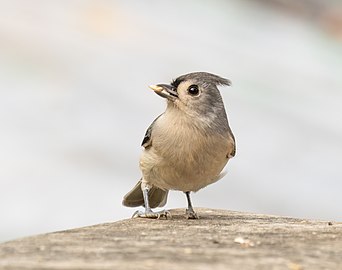|
Tufted titmouse
The tufted titmouse (Baeolophus bicolor) is a small songbird from North America, a species in the tit and chickadee family (Paridae). The black-crested titmouse, found from central and southern Texas southward,[2] was included as a subspecies but now is considered a separate species, Baeolophus atricristatus.[3] EtymologyThe generic name Baeolophus translates to "small crested" and is a compound of the Ancient Greek words βαιός: baiós meaning "small", and λόφος: lόphοs meaning "crest". The specific name bicolor means "two-colored". DescriptionMeasurements:[4]
A small bird, the tufted titmouse has a white front and gray upper body outlined with rust-colored flanks. Other characteristics include its black forehead and the tufted grey crest on its head.[5] In juveniles, the black forehead is greatly diminished such that it may be confused with the oak titmouse (although their ranges do not overlap). Males tend to be larger than females.[6] The song of the tufted titmouse is usually described as a whistled peter-peter-peter, although this song can vary in approximately 20 notable ways.[7] Distribution and habitatThe habitat of the tufted titmouse is deciduous and mixed woods as well as gardens, parks, and shrublands. Although it is non-migratory and originally native to the Ohio and Mississippi River basins, factors such as bird feeders have caused it to occupy a larger territory across the United States and stretching into Ontario and Quebec in Canada.[5][6][8] During the second half of the 20th century and into the 21st century, the species' range has been expanding northwards.[4] Behavior and ecologyThe tufted titmouse gathers food from the ground and from tree branches, frequently consuming a variety of berries, nuts, seeds, small fruits, insects, and other invertebrates.[9] Caterpillars constitute a major part of its diet during the summer. This species is also a regular visitor to bird feeders.[10] Its normal pattern is to scout a feeder from cover, fly in to take a seed, then fly back to shelter to consume the morsel, though caching is also very common.[9][11] The tufted titmouse can demonstrate curiosity regarding humans and sometimes will perch on a window ledge and seem to be peering into the house. It may also cling to the window frames and walls of buildings seeking prey in wasp and hornet nests.[citation needed] The tufted titmouse is very vocal and will respond to sounds of agitation in other birds.[4] This species readily forms small flocks, known as troupes or banditries, which often associate with chickadees and other passerines when foraging.[12] BreedingTufted titmice nest in a hole in a tree, either a natural cavity, a human-made nest box, or sometimes an old woodpecker nest.[13] They line the nest with soft materials, sometimes plucking hair from live mammals to use as material, a behavior known as kleptotrichy.[14][15] If they find snake skin sheds, they may incorporate pieces into their nest.[16] Eggs measure under 1 inch (2.5 centimetres) long and are white or cream-colored with brownish or purplish spots.[17] Eggs have an incubation period of 12–14 days; titmice will then remain nestlings for 15–16 days.[4] The lifespan of the tufted titmouse is approximately 2.1 years, although it can live for more than ten years.[18] Average clutch size is five to seven eggs.[19] Unlike many birds, the offspring of tufted titmice will often stay with their parents during the winter and even after the first year of their life.[20] Sometimes, a bird born the year before will help its parents raise the next year's young.[21] The tufted titmouse will occasionally hybridize with the black-crested titmouse; the hybridization range is very narrow, however, because of genetic differences.[6] StatusFrom 1966 to 2015 the tufted titmouse population has increased by more than 1.5% per year throughout the northeastern U.S.[22] The current breeding population is estimated to be approximately 8 million.[4] GalleryReferences
External linksWikimedia Commons has media related to Tufted titmouse. Wikispecies has information related to Baeolophus bicolor.
|
||||||||||||||||||||||||||||||||||||||||||||
Portal di Ensiklopedia Dunia






